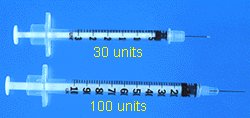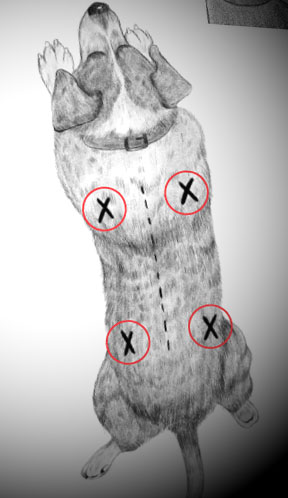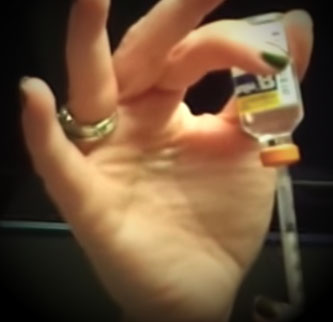Table of Contents
Overview | Selecting a Needle/Syringe | Giving the Injection | Instructions (Free PDF)
Summary:
"As part of diabetes treatment you may need to give your dog insulin injections. Dog needle use takes practice, but it is something you can learn to do. The first thing to remember about insulin is that there are lots of different kinds and each kind takes a different type of syringe. The insulin bottle will tell you the type of syringe to use (e.g.; U40 or U100).
Follow the directions below or watch the video for how to give insulin to your dog. The best place to give an insulin shot to a dog is about 1 to 2 inches from the mid back toward either the hips or shoulder blades (see diagram below.) To avoid soreness alternate locations. You may need to hold your dog or use a treat as a distraction.
Ask your pet care professional for help with how to use the needle and syringe, with this guide as a helpful reminder."
Overview
Diabetes dog needles should be selected based on the instructions provided by your veterinarian including directions for how to use insulin, a syringe, and how to actually give the shot to your dog.
Insulin needs to be handed with care since it can decline in effectiveness if directions are not followed (for example, never shake the bottle forcefully but roll the bottle between the fingers to mix the ingredients).
The following directions are from Washington State University guide to Canine Mellitus.
Be
sure to have a Veterinarian take you through these steps.
The Dog
Health Guide assumes no liability for injury to you or your pet incurred
by following these descriptions or procedures.
Selecting a Diabetes Dog Needle
Diabetes dog needle syringes used to inject insulin are not alike and come in multiple sizes:
- 30 units
- 50 units
- 100 units

Syringes come in sterile paper, plastic wrapping or a plastic case. The needle is covered with a plastic cap to keep it sterile. Use a new syringe-needle combination for each injection.
Insulin syringes have the needle attached. It is covered with a plastic cap to prevent the needle from puncturing the wrapping and to keep the needle from bending or breaking.
Remove the syringe and needle from the outer wrapping. Do not remove the needle cap until you are ready to draw insulin into the syringe. The plunger fits inside the hollow barrel of the syringe and is pulled part way out of the barrel to draw insulin into the syringe. The plunger is pushed into the barrel of the syringe to push insulin through the needle. The finger grip makes it easier to hold the syringe.
What Size Needle to Give Dog Insulin?
There are different types of dog insulin. The insulin packaging will indicate the size of the needle such as a U30 or a U100.
100 unit syringes are numbered by 10's; 10, 20, 30, etc. The smallest lines between the numbers on a 100 unit syringe measure 2 units of insulin.
30 unit syringes are numbered by 5's; 5, 10 , 15, etc. The smallest lines between the numbers on a 30 unit syringe measure 1 unit of insulin.
The position of the TOP of the black rubber stopper on the plunger is used to measure the volume of insulin in the syringe. The TOP of the black rubber stopper is the part closest to the needle.
Best Place to Give Insulin Shot In Dogs
The best place to give an insulin shot in dogs is usually about 1 to 2 inches from the middle of the back toward the hip bone or shoulder blade. Alternate locations each time to avoids skin soreness in any one area.

Practice with a Diabetes Dog Needle
One way to practice giving shots with a diabetes dog needle is to use a needle/syringe and inject the right amount of liquid using water into a piece of fruit.
Diabetes Dog Needle: Injection
Review these steps so you are prepared when giving your dog insulin. After a few times, it will become easier.When you are ready to give your dog the injection, remove the plastic cap from the needle.
1. When you are ready to give your dog the injection, remove the plastic cap from the needle.
2. Hold the syringe between the thumb and index finger. Pull back on the plunger to the desired dose level drawing some air into the syringe.
You can either pull back the plunger of the diabetes dog needle using the middle finger of the hand holding the syringe, or hold the syringe in your left hand between the thumb and index finger, and use the thumb and index finger of the other hand to pull the plunger.
As an alternative approach you can place your index finger against the finger grip and pull the plunger with your thumb and middle fingers.

3. Hold the insulin bottle upside down in your left hand if you are right handed (opposite for left-handed individuals).
Place the needle in the center of the rubber stopper. If the needle is not centered you may be trying to force the needle through the metal ring that is holding the rubber stopper in place and will break the needle. Use your thumb to push the plunger and inject the air into the bottle.
The air is placed in the bottle so a vacuum does not form in the bottle which makes it more difficult to draw insulin from the bottle. Insert the entire length of the needle into the insulin bottle as long as the tip of the needle is in the fluid in the bottle. Insulin needles are very thin and easily bent. You are less likely to bend the needle while drawing insulin into the syringe, if the needle is inserted all the way into the bottle. If there is only a small amount of insulin left in the bottle, you may only be able to insert the needle into the bottle part way or else you will pass through the fluid and into the air in the bottle.
4. Draw back on the plunger to the correct dose using your middle finger to pull back the plunger. If it is difficult for you to pull the plunger with your middle finger, you can use the thumb and index finger to pull the plunger. So that you do not pull the needle out of the bottle, curl the three fingers of your right hand that are not holding the bottle around the syringe trapping it against your palm. Then pull the plunger with the thumb and index finger. Your fingers may be covering the numbers on the syringe so draw more than you need, then push the extra back into the bottle, until the correct amount remains in the syringe...or place your index finger against the finger grip to keep the needle from pulling out of the bottle and pull the plunger with your thumb and middle fingers. If there is an air bubble in the syringe, draw a little more insulin than the correct dose.
5. Remove the syringe and needle from the insulin bottle. Holding the syringe with the needle pointed up, gently "flick" the syringe to get the air to rise to the top. Press the plunger with your thumb to push the air out of the syringe, until the correct amount of insulin remains in the syringe. There is 1 unit between each back line on this smaller syringe. Smaller syringes allow for more accurate measurements of small amounts of insulin. The top of the black rubber stopper is half way between 14 and 15 units.
6. Pinch up a fold of skin anywhere along the neck or back using your left hand if you are right-handed. Use your right hand to place the needle into the skin fold along the long axis of the fold.
7. The skin does not need to be disinfected before inserting the needle. Usually the skin is not cleansed before inserting the needle. If your dog has a normal immune system, the few bacteria that are pushed under the skin with the needle will be killed by the dog's immune system.
8.You can use alcohol on a cotton ball to make the hair lay flat so it is easier to see where the hair ends and the skin starts. Alcohol takes about 30 minutes before bacteria are killed, so just swiping the hair with alcohol is not effective in killing bacteria. If you place the needle in the opposite direction, across the skin fold, it is more likely that the needle will go through one fold of skin and out the other fold of skin, or may poke into your finger.
9. Pull back the plunger. If you get air, you placed the needle through both folds of skin. Remove the needle and try again. If you get blood, the tip of the needle is in a blood vessel. Remove the needle and try again. If you get neither air nor blood, the needle is placed correctly and you can push the plunger to inject the insulin.
Reminder: Be sure to give the insulin shots in different locations each time.
Note: Syringes and dog needle(s) used to give insulin should not be discarded in the trash, but should be placed in a puncture-proof container and taken to your veterinarian for disposal.
Download These Instructions
Instructions on how to give insulin to a dog.
Source
Washington State University: Pet Health Topics on Diabetes Mellitus.
